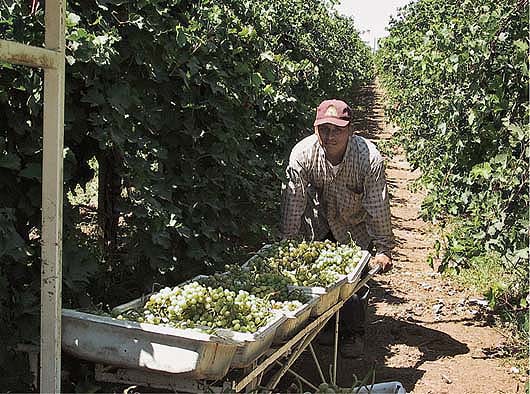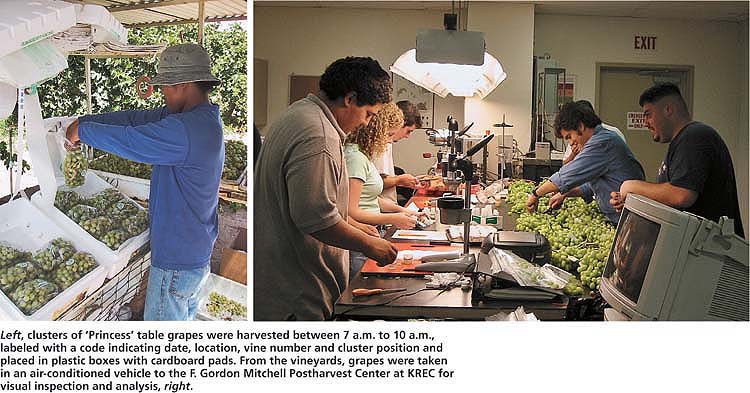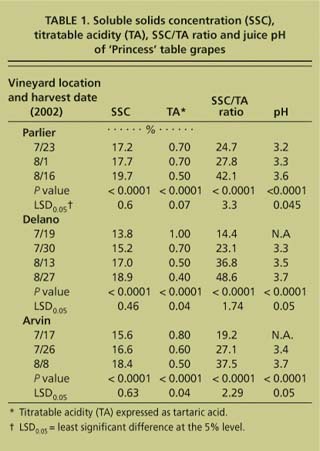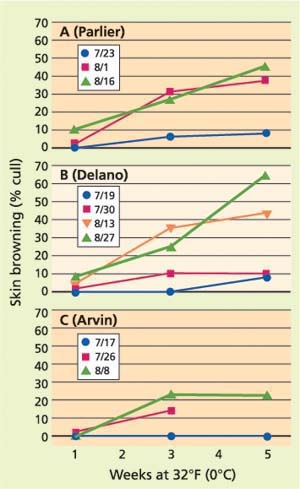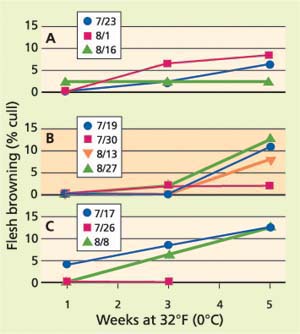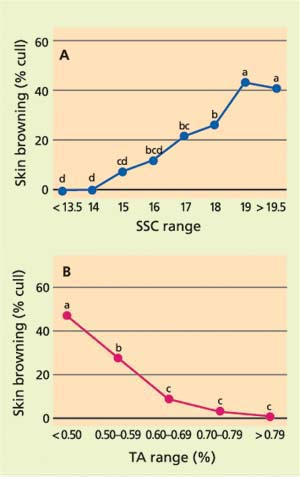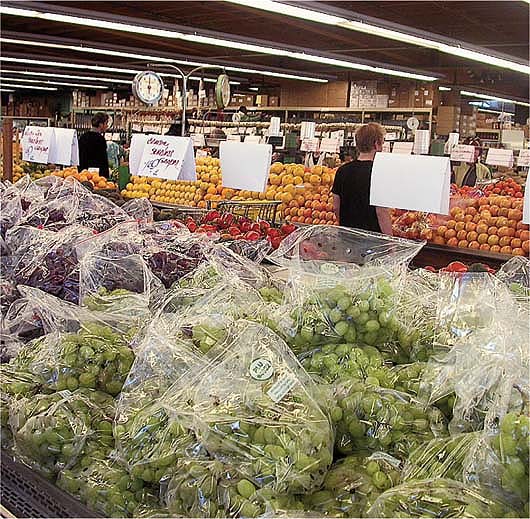All Issues
Early harvest delays berry skin browning of ‘Princess’ table grapes
Publication Information
California Agriculture 59(2):103-108. https://doi.org/10.3733/ca.v059n02p103
Published April 01, 2005
PDF | Citation | Permissions
Abstract
Table grapes commonly suffer from tissue browning during harvest, packing, storage and shelf life, resulting in lower prices and reduced access to markets. We evaluated the development of browning symptoms in ‘Princess’ table grapes. The berries had high skin browning but very low flesh browning incidences. The most skin browning was found in highly mature grapes and appeared after 3 weeks of cold storage. Skin browning was directly related to fruit maturity, but vineyard location had a greater impact on the incidence of skin browning than maturity. In all locations, the skin browning susceptibility of ‘Princess’ table grapes rapidly increased when the berries reached a titratable acidity of less than or equal to 0.60% and/or a soluble solids concentration greater than or equal to 18.0%. Based on this work, we recommend harvesting ‘Princess’ at a soluble solids concentration between 16.0% and 18.0%.
Full text
Table grapes commonly suffer from variations of tissue browning including stem browning (Crisosto et al. 2001), internal flesh browning (Nelson 1969) and berry (skin and flesh) browning (Crisosto, Badr, et al. 2002; Vial 2003) during harvest, packing, storage and shelf life. Table grapes that suffer from browning disorders normally have a shorter postharvest shelf life and may not be utilized for long-distance markets, which are often the most profitable. In general, table grapes with browning problems garner lower prices than grapes without them.
We studied postharvest berry browning in ‘Princess’ (originally known as ‘Melissa’), a white, seedless, table grape cultivar developed and released by the USDA's Agricultural Research Service in 1999 (Ramming 1999). ‘Princess’ resulted from the cross of ‘Crimson Seedless’ with ‘B40–208’ in 1988. ‘B40–208’ is a white, seedless selection and is a complex hybrid whose parents include ‘Italia’, which is well known to exhibit berry browning symptoms. According to the California Agricultural Statistics Service, in 2003 there were 1,329 acres (325 acres nonbearing) planted in the state. In 2000, we conducted a preliminary postharvest evaluation of ‘Princess’ and observed various berry browning symptoms similar to those seen in ‘Italia’.
Top and bottom right, fresh-market table grapes are vulnerable to browning of skins and flesh during harvesting, packing, storage and shelf life. Research has shown that this browning can be reduced in ‘Princess’ table grapes, left, by harvesting when soluble solids range between 16.0% and 18.0%.
Berry browning occurred either as an irregular shape and scattering on the surface of the berries restricted to the skin, which we called “skin browning,” or as partial or total browning restricted to the flesh, which we called “flesh browning.” These berry browning symptoms were different from those described in a 1992 UC DANR bulletin (Luvisi et al. 1992) as “internal browning” for ‘Thompson Seedless’. The ‘Princess’ berry browning symptoms are frequently expressed on white table grape cultivars, including ‘Italia’, ‘Regal Seedless’ and others. In the few cases where internal browning has been reported on ‘Thompson Seedless’, the browning started parallel to the vascular system in the center of the berry and never developed on the skin as it does in ‘Princess’.
We investigated if the development of postharvest berry browning problems in ‘Princess’ was related to cluster maturity parameters such as soluble solids concentration (SSC), titratable acidity (TA), the SSC/TA ratio and juice pH.
Maturity and berry browning
To study the relationship between grape maturity and berry browning incidence, ‘Princess’ table grapes were harvested during the 2001 and 2002 seasons at three soluble solids concentration (SSC) ranges: low (13% to 16%), moderate (16% to 18%) and high (greater than 18%).
During the 2001 season, ‘Princess’ table grapes were harvested at three different maturities at California State University, Fresno, from research plots in a vineyard comprised of 6-year-old, cane-pruned vines. The vines were supported by a wide “V” trellis system, and vine and row spacings were 7 feet (2.3 meters) and 12 feet (3.7 meters), respectively. A drip irrigation system was installed at planting time in 1996. The entire block received a gibberellic acid (1.0 gram per acre) bloom-thinning treatment at 80% bloom. Standard cultural practices of irrigation, pest management and canopy management were applied to the entire block. Twelve healthy vines were selected and labeled for this experiment, with each vine serving as a replicate. Four clusters were harvested from each vine on July 19, July 27 and Aug. 2, 2001, and each cluster was labeled to identify its date of harvest and vine number.
During the 2002 season, ‘Princess’ table grapes were harvested at the same three levels of maturity from three commercial vineyards located in major table grape production regions of the San Joaquin Valley: Parlier (Fresno County), Delano (Tulare County) and Arvin (Kern County). These vineyards were carefully chosen based on their similar age, vigor (moderate to high) and management practices. At all three sites, the spacing was 12 feet (3.7 meters) between rows and 8 feet (2.4 meters) between vines, with drip irrigation; and clusters were tipped and the trunks girdled using a 3/8-inch knife immediately after berry set. Twelve healthy grapevines were randomly selected and labeled at each site for the study (Dokoozlian et al. 2001). In 2002, the ‘Princess’ grapes were harvested in Parlier on July 23, Aug. 1 and Aug. 16; Delano on July 19, July 30, Aug. 12 and Aug. 27; and Arvin on July 17, July 26 and Aug. 8.
‘Princess’ table grapes were harvested at different maturity levels from three San Joaquin Valley vineyards. Researchers determined that vineyard location and management practices had a greater influence on tissue browning than maturity in this cultivar. Trellis systems, nitrogen fertilization, canopy management and rootstocks could play important roles in controlling excess sunlight and hence browning problems.
In Parlier, 5-year-old ‘Princess’ vines were grown on their own root-stock in fine sandy loam soil. Six canes, along with four to six two-bud spurs, were retained on each vine at pruning. Gibberellic acid was applied at 1 gram per acre near full bloom to reduce berry set. Vine rows were oriented east-west.
In Delano, 8-year-old ‘Princess’ vines were grown on their own root-stock in clay loam soil. Vines were bilateral-cordon trained and were pruned using a combination of spurs and canes (approximately eight to ten two-bud spurs and six to eight 15-bud canes per vine) on a “V” trellis system. The vineyard was not treated with gibberellic acid, which is used to reduce berry set and/or increase size. The vines were adjusted to similar crop loads (approximately 20 clusters per vine). Vine rows were oriented east-west.
In Arvin, 8-year-old ‘Princess’ vines were grown on Freedom rootstock in sandy loam soil. Vine rows were oriented north-south. Vines were pruned using six to eight 12-bud canes and trellised to an open gable system. Gibberellic acid was applied twice. First, 1.5 grams per acre was applied at 80% bloom to reduce fruit set, then 20 grams per acre was applied at fruit set (0.2 to 0.3 inches [6 to 8 mm berry size]) to increase berry size. Clusters were tipped and the vines were adjusted to similar crop loads (approximately 35 clusters per vine).
During both seasons, four clusters were harvested from each replication (48 clusters per harvest date per location total) on each harvest date. Clusters were harvested in the morning (7 a.m. to 10 a.m.) and labeled with a code that included the harvest date, location, vine number and cluster position. Harvested clusters were placed into plastic boxes with cardboard pads in the bottom to reduce abrasion damage and were immediately transported to the F. Gordon Mitchell Postharvest Center at the UC Kearney Research and Extension Center in an air-conditioned vehicle.
Left, clusters of ‘Princess’ table grapes were harvested between 7 a.m. to 10 a.m., labeled with a code indicating date, location, vine number and cluster position and placed in plastic boxes with cardboard pads. From the vineyards, grapes were taken in an air-conditioned vehicle to the F. Gordon Mitchell Postharvest Center at KREC for visual inspection and analysis, right.
Quality evaluation at harvest
During both seasons, each cluster was visually evaluated for skin browning upon arrival at the postharvest facility. When more than 15% of the berries were discolored (skin browning), clusters were considered visually unacceptable. After the visual quality evaluation, five berries per cluster were carefully removed to determine firmness, soluble solids concentration, ti-tratable acidity and juice pH (Crisosto, Garner, et al. 2002), which are physical and chemical parameters used to assess berry quality.
These five berries from each replication were pooled (for a total of 60 berries for each set of 12 experimental vines) and pressed through cheesecloth to extract the juice. Soluble solids concentration was measured with a temperature-compensating refractometer (model ATC-1, Atago Co., Tokyo, Japan). Juice titratable acidity and undiluted pH were measured with an automatic titrator (Radiometer, Copenhagen, Denmark) at a final pH of 8.2 and reported as percentage tartaric acid, which is the predominant organic acid in grapes.
At the same time that these measurements were taken, labeled clusters from each harvest date were carefully packed using a plastic pad that slowly released sulfur dioxide (SO2; 7 grams of sodium metabisulfite)(Tedmark, South Africa) — combined with a perforated, polyethylene box liner (1/4-inch hole, 3-inch center) — to reduce water loss and assure Botrytis cinerea control without causing bleaching (Crisosto et al. 1994). Clusters were placed inside a plastic cluster bag and packed in 15.7-by-19.7-inch (40-by-50-centimeter) fiberboard boxes as is done commercially. The slow release, one-phase sulfur-dioxide-generating pad was used in the top of each box, above the cluster plastic bags but inside the box liner. Finally, the boxes were labeled and stored at 32°F (0°C) and 80% relative humidity.
Storage quality evaluation
In the 2001 season, clusters from the three harvest dates were removed from cold storage at 12 weeks after harvest for visual browning evaluations. The number of berries in the sample with skin browning covering more than 25% of the berry's surface was recorded. If more than 15% of the berries in the sample had skin browning, the cluster was deemed “unacceptable” (cull).
In the 2002 season, clusters from each harvest date were removed from cold storage 1, 3, 5 and 7 weeks after harvest for visual browning evaluations. At 1, 3 and 5 weeks after harvest, incidences of berry skin browning and flesh browning were visually evaluated. Flesh browning incidence was the percentage of clusters with one or more berries showing symptoms. At about 7 weeks after harvest (7 weeks at 32°F [0°C] plus 2 days at 68°F [20°C]), all berries were removed and weighed, and skin browning incidence was expressed as a percentage of cluster weight. Flesh browning and internal browning were also expressed as a percentage of cluster weight after each berry was cut in half and examined internally.
Since harvest dates were different at each location, the interaction between harvest date and location was not studied. In both seasons, harvest date was used independently as a main treatment within each location. Twelve vines were used as replicates and four clusters from each replicate were harvested as experimental units. Data analysis was done by ANOVA, whereas mean comparison was carried out by LSD (P < 0.005) using SAS.
Harvest date and maturity
In Parlier, there were no significant differences in soluble solids concentration among samples collected on the first two harvest dates (17.2% and 17.7%), while samples collected on the third harvest date had a significantly higher soluble solids concentration (19.7%) than those collected on the first two dates (table 1). Titratable acidity decreased significantly between the first and third harvest dates (from 0.70% to 0.50%). The SSC/TA ratio also increased significantly during this period (from 24.7 to 42.1), but did not change significantly between the first two sampling dates. Similarly, juice pH increased between the first and third harvest dates (from 3.2 to 3.6).
TABLE 1. Soluble solids concentration (SSC), titratable acidity (TA), SSC/TA ratio and juice pH of ‘Princess’ table grapes
TABLE 2. Skin browning and flesh browning after 7 weeks of storage at 32°F (0°C) for ‘Princess’ table grape berries
In Delano, the soluble solids concentration increased significantly between the first and third harvest dates (from 13.8% to 18.9%)(table 1), as did the SSC/TA ratio (from 14.4 to 48.6). During this period, titratable acidity decreased significantly (from 1.00% to 0.40%). Juice pH increased significantly between the second and third harvest dates (from 3.3 to 3.7).
In Arvin, the soluble solids concentration increased significantly between the first and third harvest dates (from 15.6% to 18.4%)(table 1). During this period, titratable acidity decreased significantly (from 0.80% to 0.50%) and the SSC/TA ratio increased significantly (from 19.2 to 37.5). Juice pH increased significantly between the second and third harvest dates (from 3.4 to 3.7).
Harvesting late resulted in an increase in soluble solids concentration and a reduction in the titratable acidity, thus the SSC/TA ratio increased in the mature grapes.
Harvest maturity and storage time
In both seasons, skin browning was related to harvest date and in turn, grape maturity, but was very low at harvest for all three maturities. Flesh browning was so low that it was not commercially important (< 2.0%), and internal browning was not observed at all. Skin browning was related to grape maturity, because after 12 weeks of storage, grapes from the early harvest had significantly less skin browning than grapes harvested later (fig. 1). Significant changes in skin browning incidence occurred when the soluble solids concentration increased from about 18% to 19% (fig. 1A).
Fig. 1. Relationship between ‘Princess’ table grape harvest date and (A) soluble solids concentration (SSC) measured at harvest and (B) skin browning measured after 12 weeks of storage at 32°F (0°C), 2001 season.
Fig. 2. Relationship between harvest date and the development of berry skin browning in ‘Princess’ table grapes grown in (A) Parlier, (B) Delano and (C) Arvin, during 5 weeks of storage at 32°F (0°C), 2002 season.
In Parlier, skin browning incidence was low after a week of cold storage, varying from 0% to 10.4% depending on the 2002 harvest date (fig. 2). After 3 weeks, skin browning incidence increased from 6.3% to 31.8%, and after 5 weeks reached 8.3% to 45.8%. Similarly, in Delano the incidence of skin browning was low after a week of cold storage, but increased dramatically after 3 weeks for the second harvest (35%) and reached up to 64.6% after 5 weeks for the fourth harvest. In Arvin, skin browning incidence was substantially lower than in Parlier and Delano but followed a similar pattern of development, increasing with time in cold storage.
After 7 weeks in cold storage, skin browning expressed as a percentage of cull clusters increased significantly in grapes from all three locations (table 2), increasing from the first to the last harvests from 0% to 58.2% in Parlier, 0.3% to 55.5% in Delano, and 0.1% to 14.4% in Arvin. Soluble solids concentration, SSC/TA ratio and pH were significantly positively correlated with skin browning, while titratable acidity was significantly negatively correlated (data not shown). Furthermore, the flesh browning incidence in grapes at all three locations was low after 3 weeks of cold storage but increased dramatically after 5 weeks (fig. 3).
There were no significant differences between harvest dates in a specific location and the duration of cold storage, but there was a clear trend of increasing flesh browning during storage on a specific harvest date. It is important to note that flesh browning during the first 5 weeks of cold storage was measured visually and is therefore subjective. However, even in these evaluations, flesh browning was not a major problem and only reached a maximum of 12.5% among all locations after 5 weeks in cold storage.
After 7 weeks in cold storage, flesh browning incidence expressed as a percentage of cull clusters did not increase significantly during the 2002 harvest period (table 2). Flesh browning incidence was so low (about half a berry per cluster) that it did not have commercial implications and was not related to maturity. In general, ‘Princess’ table grapes collected from the three locations in California during the 2002 season developed skin browning but not flesh browning during storage.
Fig. 3. Relationship between harvest date and the development of berry flesh browning in ‘Princess’ table grapes grown in (A) Parlier, (B) Delano and (C) Arvin, during 5 weeks of storage at 32°F (0°C), 2002 season.
In contrast, our group reported a significantly higher flesh browning incidence in 2001 than 2002 (Crisosto, Badr, et al. 2002). The differences can be explained by the vineyard conditions in the 2002 study, which were carefully chosen for vines with well-balanced vigor and with healthy and shaded canopies. During the 2001 season, the ‘Princess’ table grapes were grown in sun-exposed and low-vigor vineyards and subsequently showed more browning problems.
Significant development of skin browning occurred during cold storage of ‘Princess’ table grapes from all three vineyards. Skin browning was observed after 3 weeks in cold storage and it was strongly correlated with maturity. This data agrees with our previous work (Crisosto, Badr, et al. 2002), in which the incidence of skin browning after 3 weeks at 32°F (0°C) was directly associated with increases in fruit harvest maturity. ‘Princess’ table grapes that were harvested at low soluble solids concentrations exhibited lower skin browning incidence than those harvested at values above about 18%. Skin browning increased sharply when soluble solids concentration was greater than 16.0% to 18.0% (fig. 4A). High values of titratable acidity concur with a low incidence of skin browning, and maturity was strongly correlated with titratable acidity. Grapes harvested at titratable acidity values between 0.60% and 1.00% showed significantly lower skin browning incidence than those harvested at titratable acidity values below 0.60% (fig. 4B). The degradation of organic acids, such as tartaric, citric and malic, occurred along with fruit maturation. SSC/TA ratios below 25 were associated with considerably lower skin browning than those above 25 (table 1).
Fig 4. Relationship between ‘Princess’ table grape berry skin browning and (A) soluble solids concentration (SSC) and (B) titratable acidity (TA), 2002 season.
However, vineyard location and management were more important than maturity in tissue browning in ‘Princess’ table grapes. There are many possible reasons for this. First, the phenolic concentration, type of phenolic compounds and polyphenoloxidase (PPO) activity vary for the same cultivar among locations, and from year to year (Sapis et al. 1983). The browning capacity for a specific cultivar and among locations can also be affected by management practices such as irrigation, fertilization, rootstock, trellis system, pruning systems and canopy management (Sapis et al. 1983; Wissemann and Lee 1981). For example, trellis system, nitrogen fertilization, canopy management and rootstocks could play important roles in controlling excess sunlight and hence browning problems.
Consumers have come to expect unblemished table grapes in the produce section. Postharvest research is helping growers to supply fresh, attractive produce for the marketplace.
Growing location is important
Skin browning incidence at harvest was low but its level depends on the level of physical abuse during harvesting operation. The skin browning incidence reached its highest expression after 3 weeks in cold storage and was strongly related to maturity and vineyard location. The effect of location on skin browning incidence was more important than maturity. Flesh browning and internal browning incidences were not commercially important (≤ 2.0%).
The skin browning susceptibility of ‘Princess’ table grapes increased when berries were harvested at titratable acidity levels less than 0.60% and/or soluble solids concentrations greater than or equal to 16.0%; grapes harvested at an advanced stage of maturity (≥ 18.0% SSC) were more susceptible to tissue browning. To maximize storage potential and taste, ‘Princess’ grapes should be harvested at a soluble solids concentration between 16.0% to 18.0%.
Skin browning was highly influenced by vineyard location or management; ‘Princess’ table grapes grown under the specific management conditions of the plot located in Arvin had two to three times less skin browning incidence than those grown in Delano and Parlier.




